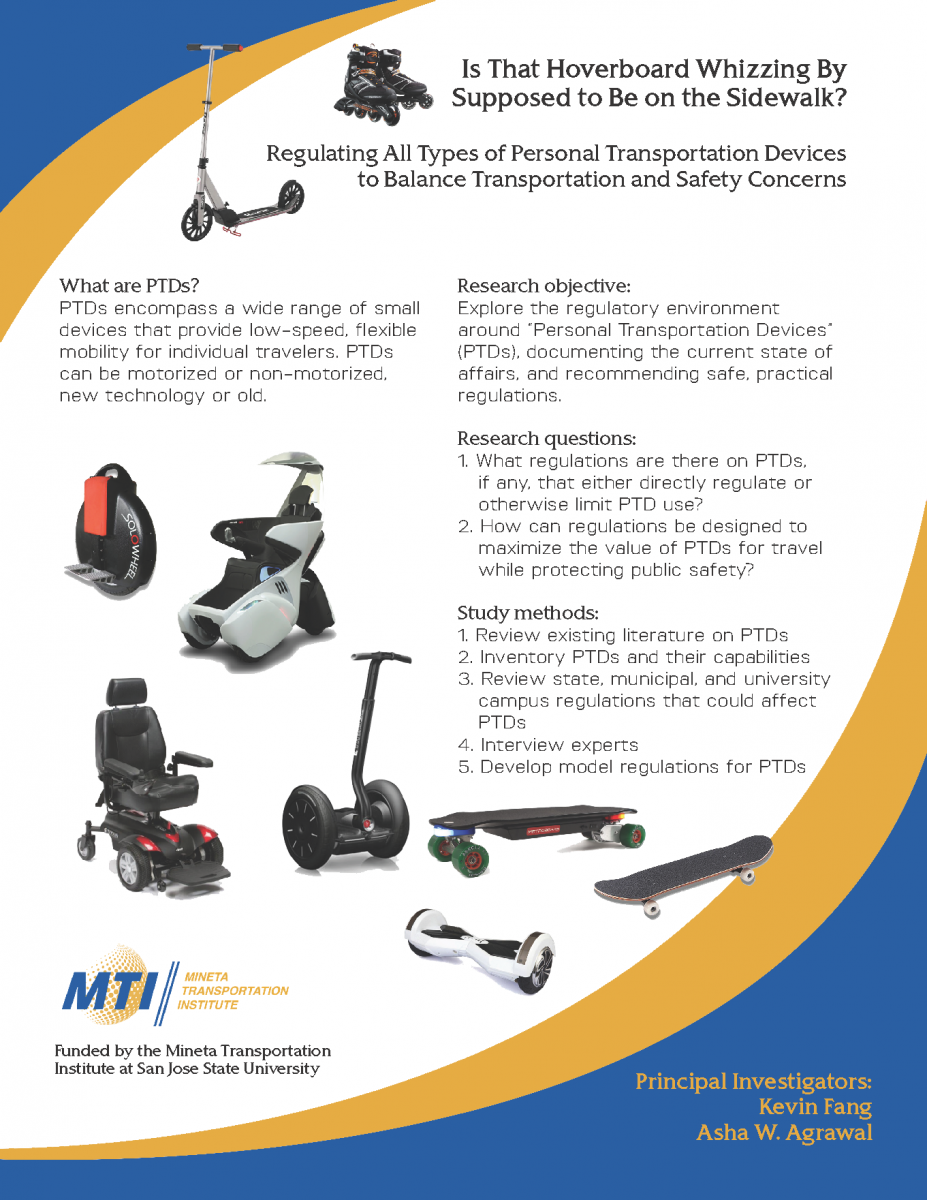- 408-924-7560
- mineta-institute@sjsu.edu
- Donate
How and Where Should I Ride This Thing? “Rules Of The Road” for Personal Transportation Devices
In recent years, “Personal Transportation Devices” (PTDs) have exploded onto streets and sidewalks. These small devices transport individual persons at slow speeds and are either human-powered or  motorized. Examples include electric (kick) scooters, skateboards, e-skateboards, roller blades, and Segways. One key to successfully integrating PTDs into community streets will be the implementation of consistent and suitable regulations over user behavior: “rules of the road” for PTD riders. To help local officials identify appropriate rules for rider behavior, this report documents and analyzes existing PTD regulations across 176 jurisdictions and then presents recommendations for a set of state-level “rules of the road” designed to balance safety and freedom of movement for all road users, including PTD riders.
motorized. Examples include electric (kick) scooters, skateboards, e-skateboards, roller blades, and Segways. One key to successfully integrating PTDs into community streets will be the implementation of consistent and suitable regulations over user behavior: “rules of the road” for PTD riders. To help local officials identify appropriate rules for rider behavior, this report documents and analyzes existing PTD regulations across 176 jurisdictions and then presents recommendations for a set of state-level “rules of the road” designed to balance safety and freedom of movement for all road users, including PTD riders.
To identify the current state of PTD rules of the road, we documented and analyzed the existing regulations at three levels of government: all 50 states and 5 U.S. territories, 101 cities, and 20 college campuses. This review found that PTD users operate in a murky regulatory environment, with rules often poorly defined, contradictory, or altogether absent.
Results of this analysis, a literature review, and interviews with 21 stakeholders, were used to craft a model state-level regulatory code that aims to introduce consistent and well-grounded regulation of PTDs. The general philosophy underpinning the model legislation is that PTD rules should protect public safety, permit PTD use as a convenient travel option, be easy to understand and remember, allow for new devices without new regulations, and be based on facts about PTD use and users. Working from these principles, core recommended elements of the recommended PTD regulations are as follows: states should set comprehensive regulations for PTD riders (with local gov-ernments given flexibility to limit certain uses when necessitated by local conditions); PTDs should be regulated as a class, not device-by-device; and PTD users should be permitted to ride on both streets and sidewalks, subject to rules that protect safety and free movement for all travelers.
Mineta Transportation Institute
San José State University
210 N. 4th St., 4th Floor
San José, CA 95112
kevin.fang@sjsu.edu
asha.weinstein.agrawal@sjsu.edu
U.S. Department of Transportation, Office of the Assistant Secretary for Research and Technology – $63,313.25
-
Contact Us
SJSU Research Foundation 210 N. 4th Street, 4th Floor, San Jose, CA 95112 Phone: 408-924-7560 Email: mineta-institute@sjsu.edu





